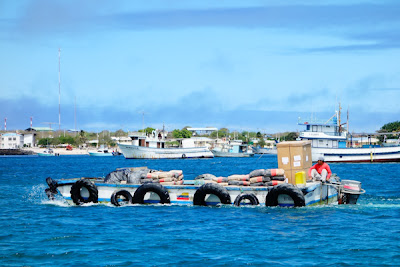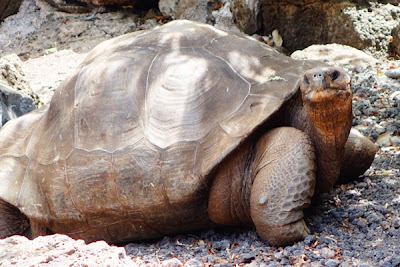Here we are in the Galapagos, the easternmost island of San Cristobal to be precise, after an expeditious five-day on-the-wind* passage from Bahia de Caraquez, Ecuador, on the continente.
And here’s a cheesecake shot of the new ‘poster boy’ of Isla San Cristobal, the giant Galapagos tortoise known as Pepe. (The famous Lonesome George-Solitario Jorge, died in 2012. He’s being taxidermic for his next posting, to the American Museum of Natural History.) Pepe, a middle-aged hunk who measures four feet or more (a guess) and weighs in the hundreds of pounds, is spending his days posing for photos inside a rock-walled enclosure at the Interpretation Center near Puerto Baquerizo Moreno. A native of San Cristobal, he is said to be active in the breeding program for his subspecies – a true patriarch! He keeps a sharp, even intelligent, eye on the corner of the enclosure where all the tourists approach.
Pepe and I came into this world in the ~same year, according to his reader board bio, and are coming to share other certain features as well. With a potential lifespan of twice mine **, he’ll get good service from the tougher carapace he received, even if it is scratched around the edges.
The mere words Islas Galapagos conjure up so many images: ideas in natural history thanks to Charles Darwin of course, but also history, geography, vulcanology, even romance. Herman Melville called them ‘enchanted’; but he meant in the ‘bewitched’ even accursed sense, not pastel Disney-style of enchantment.
Melville’s vivid description sticks in the mind: “Take five-and-twenty heaps of cinders dumped here and there in an outside city lot; imagine some of them magnified into mountains, and the vacant lot the sea, and you will have a fit idea of the general aspect of the ‘Enchanted Isles’…it is to be doubted whether any spot of earth can, in its desolateness, furnish a parallel with this group.” Darwin was a little more positive, merely comparing the land to the cultivated areas of the Infernal regions.
 |
| A photo of the diorama in the San Cristobal Interpretation Center, with Isabela in the foreground, Santa Cruz the most populated island to the east, and San Cristobal out of sight further east. |
Coming upon these islands as we did on a dark night, lit only by star shine and not much of it, one does have a ‘present at creation’ feeling. The silhouette is bleak, perhaps cloud-draped, and you can imagine, if not actually hear, the perpetual crash of the southwesterly swell on the lava-sharp coastline and offlying rocks and islands, while you imagine being set upon them by unpredictable currents. Desolate indeed! You can actually hear, and feel, as you pass through disturbed patches of what we call ‘devil water’
We have real paper charts, and it’s a good thing too, because details that you could count upon the British Admiralty charting services for, are entirely absent from some of the electronic charts. X marks the rock, or maybe a speck of tan, but is it awash, submerged, or 50 feet tall? It’s irrelevant to the folks at C-Map, but not to me! Also some of the charts are off, so not the place for first time night arrival.
So the reality of the capital of the Galapagos province, Puerto Baquirizo Moreno on San Cristobal, comes as a surprise. It’s anything but desolate. Ashore is an everyday all-Ecuadoran town with nice sidewalk and street paving, which, absent the jokey BlueBooby t-shirts and last-minute specials posted in front of the dive shops, could be anywhere in the country.
 |
||
| I like this tee shirt better than the Blue Booby ones anyhow. |
There is a lot of new masonry construction, even a building crane or two. The airport is a ten-minute walk over the hill. The harbor is full of boats, 15 feet to 150 meters. Yellow water taxis and tourist boat ‘lanchas‘ circulate constantly. Cargo is ferried ashore in lighters, since there’s not sufficient depth for freighters at the docks.
Residents and tourists stroll the Malecon, shops line the streets heading inland, and a few blocks further the neighborhoods turn residential. There are hibiscus and banana trees, cats and dogs (not so many as on the ‘continente’ though, and healthier), bicycles, motor scooters and lots of pickup trucks, nice late-model Toyotas which also function as taxis. Melville never mentioned vegetation! And the whalers he was traveling with didn’t look like this.
The only thing a little odd is the welcoming committee.
Sea lions are everywhere, dozing on the docks, draped over the park benches, sleeping on the sidewalks. There may be more sea lions than Galapagonians! Wikipedia thinks so. They are cute, and fun to watch as they twitch and rustle in their dreams. But they reminded me of Canada geese, in the sense that you don’t want to see them in this way or quite so close. If you’re curious, I can report that sea lion droppings are about like those of a healthy German shepherd, only whiter (from fish bones?), and sometimes with a runny ‘gravy’. Better than geese (all ‘gravy’) in this respect. Someone must go thru the waterfront early with a fire hose to give each day a fresh start.
Sea lions also have a fondness for the steps on the backside of catamarans, and dinghies on the beach or in the water, which contributed to our decision to just use the water taxis, $1 per person each way, and some social benefits. Someone told me that if a sea lion spends the day lounging on your cockpit cushions, you’ll be throwing them away. That sounds a little extreme to me!
Our actual welcoming committee consisted of our agent, Bolivar Pesantes of the Naugala agency, and representatives of the port captain and the environmental department. They like banana bread, but didn’t want to drink our water, which is not bottled. The environment man put on his disposable gloves and picked through our trash can of paper and plastic (we keep biodegradables and cans/bottles separate but he didn’t ask for those). He informed me that neither used Kleenex, nor the stuff I swept off the floor could be recycled and should not be in that can. Yes sir! What was I thinking?
We paid fees for reception services(?), inspection and quarantine, national park ($100 per person), local government, photocopies and transportation of the authorities, trash, and the agent, who got almost half of our total $840 investment. We knew ahead of time about how expensive it would be but figured we’d not be likely be passing this way again. Plus, They Say it’s going up again next year. They can’t hear us screaming in Quito and Guayaquil yet.
We know a number of boats who bypass these islands and head straight to the Marquesas because of the expense. I think the authorities prefer it that way too. You the tourist would be much easier to track and manage if you would stay on one of the handful of populated islands and make day trips from your hotel or hostel. And that would be a feasible approach. However tourism in these islands seems to be set up in particular for the tour boats and their operators.
National Geographic runs a big cruise ship (96 passengers) that dwarfs the competition and maybe some islands too. Otherwise there is diversity in the fleet: a number of ‘steel box’ power cats and mega-power-yachts, a few smaller sailing boats, perfectly adequate to the job but lower on ‘ambiance’.
You’d fly in to Santa Cruz or San Cristobal, board your 3- or 4- or 8- night cruise, be ferried around to various islands by night, and to a variety of activities by day, and then you’d be gone. There is a certain logic to this, and as we see the boats moving around, we can see that the passengers are being kept busy, really busy, and they’re seeing a lot, including destinations and sights we are going to miss, mainly because we’re only allowed the three main islands, and only the main port on each.
 |
| I like how even the inflatable dinghies wear nice rope fendering on the bow. |
But despite the limitations on our movements, I think we’re getting the gist of the Galapagos.
 |
| And our view of them. Wish we could have gotten their wifi signal! |
As for the natural sciences, the history, romance, etc, a good place to start is at the Interpretation Center, just a short walk around the bay. 
We’re heading there now. Stay tuned!
*”on-the wind” meaning bumpier and less comfortable than might have been desirable
**About Pepe and his brethren, Wikipedia informs us: The Galápagos tortoise or Galápagos giant tortoise (Chelonoidis nigra) is the largest living species of tortoise and 10th-heaviest living reptile, reaching weights of over 400 kg (880 lb) and lengths of over 1.8 meters (5.9 ft). With life spans in the wild of over 100 years, it is one of the longest-lived vertebrates. A captive individual lived at least 170 years.
The tortoise is native to seven of the Galápagos Islands, a volcanic archipelago about 1,000 km (620 mi) west of the Ecuadorianmainland. Spanish explorers, who discovered the islands in the 16th century, named them after the Spanish galápago, meaningtortoise.
Shell size and shape vary between populations. On islands with humid highlands, the tortoises are larger, with domed shells and short necks – on islands with dry lowlands, the tortoises are smaller, with “saddleback” shells and long necks. Charles Darwin’sobservations of these differences on the second voyage of the Beagle in 1835, contributed to the development of his theory of evolution.
Tortoise numbers declined from over 250,000 in the 16th century to a low of around 3,000 in the 1970s. This decline was caused by exploitation of the species for meat and oil, habitat clearance for agriculture, and introduction of non-native animals to the islands, such as rats, goats, and pigs. Ten subspecies of the original fifteen survive in the wild; an eleventh subspecies (C. n. abingdoni) had only a single known living individual, kept in captivity and nicknamed Lonesome George until his death in June 2012. Conservation efforts, beginning in the 20th century, have resulted in thousands of captive-bred juveniles being released onto their ancestral home islands, and it is estimated that the total number of the species exceeded 19,000 at the start of the 21st century. Despite this rebound, the species as a whole is classified as “vulnerable” by the International Union for Conservation of Nature (IUCN).
Oh, and I almost forgot to mention: a very readable new ebook now available at Amazon. It´s a “best-of” digest from the Caribbean Compass, a cruiser´s newspaper based in the Eastern Caribbean. There are some great articles in there, and I say that not just because two of them are mine! You can check it out at:
http://www.amazon.com/Cruising-Life-Stories-Caribbean-ebook/dp/B00DO8PHJ4/ref=sr_1_1?ie=UTF8&qid=1372851986&sr=8-1&keywords=caribbean+compass+the+cruising+life.



